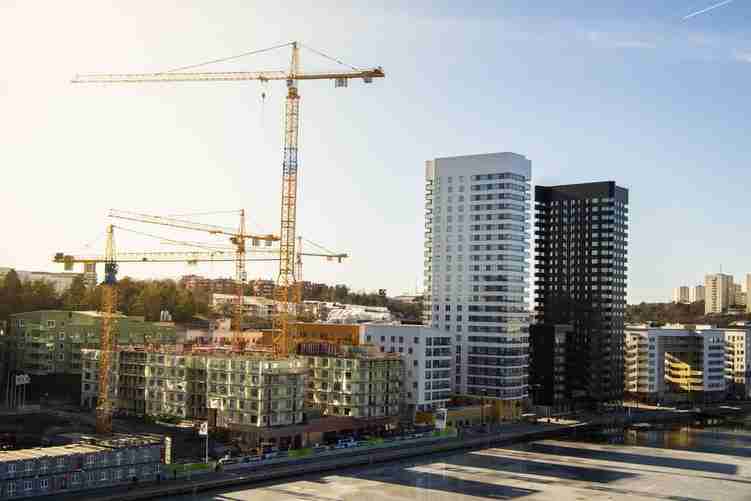DEVELOPERS, REGENERATION PROJECTS, FREEHOLDERS AND THEIR LOCAL COMMUNITY
When a graveyard is a part of land bought by developers and requires exhumation, how does this affect a community? How are freeholders and developers working with locals on urban regeneration?
BALLYMORE AND BRENTFORD LOCAL COMMUNITY
Ballymore is a major player in property development, being the proud organisation behind the Nine Elms project, partnership with Guinness in Dublin, and of course the Brentford Regeneration Project.
A project of this size is never going to please everyone, but it’s so important that the local community feel listened to. The graveyard topic was sensitive and of course the feelings ran high. If you didn’t read about it, here’s what’s happened:
St Lawrence’s Church’s graveyard is being dug up to make way for a new housing development in Brentford, which has enraged many members of the community. The graveyard contains the remains of buried war heroes, and neighbours believe they should be left to rest rather than dug up and relocated to Brookwood Cemetery in Surrey.
The church, which fell out of use in the 1960s, has been agreed to be protected by Brentford and used as a community space, but around 850 graves are being dug up, causing outrage in the community.
Members of the community have expressed their disappointment that they will not be able to pay their respects to the graves before they are relocated to Surrey.
This has sparked a discussion about how Ballymore is poor at engaging with their community and only makes an effort when people object to their plans. Members of the community argue that it is simply not enough; too many flats are being built at a time when Brentford’s heritage must be preserved.
DOES LOCAL REGENERATION IMPROVE THE LOCAL LIVING ENVIRONMENT?
Regenerating an area means creating more business opportunities, improving social amenities, and increasing overall quality of life and well-being.
High priority areas include:
- .Sink estates
- .Commuter villages
- .Declining rural settlements
Ealing Council embarked on a major regeneration programme following consultation with the community back in 1999. Seems like a lifetime ago doesn’t it?! At that time it was decided to comprehensively regenerate the area as this was seen as the best way to transform the area from the point of view of both residents and the council.
The plan included the redevelopment of all existing homes and the construction of 2517 new homes in 21 phases between 2011 and 2024. Half of all the new housing should be affordable, with more than 70% being social rent and the rest being shared ownership. The majority of current residents with secure tenancies will move to new homes once they are finished (or have already).
The plan called for more housing to be built compared to the existing estate, but with a similar or lower building height. (Maximum of 12 storeys compared to 17 storeys in the existing development ). The idea being that they would be evenly distributed across the site and a typology of courtyard flats would be introduced in place of the existing layouts which are mixed.
The council-approved plan called for the new development to be surrounded by five parkland neighbourhoods, as well as a new community hub with community, retail, and youth facilities, as well as improved access to the surrounding areas.
L&Q and Countryside were appointed in 2010 to complete the estate’s remaining regeneration work; previously, the Catalyst Housing Group built 346 new homes for rent and shared ownership. These projects are a huge partnering of surveyors, lawyers, developers, property managers, contractors and construction teams.
So does this improve the local living environments? It would seem so, yet of course there will always be residents and locals that do not like change, but if you are a resident and the council is looking after you there will always be an impact there, it’s the nature of the beast. Local authorities try their very best with the budgets they are allocated, which is why regeneration can be so effective for new, clean and secure homes.
THE SOCIAL IMPACT OF AN URBAN REGENERATION PROJECT
In 2014, the research company Social Life was commissioned (in partnership with the University of Reading) by Acton Gardens LLP to design a research framework to monitor the social impacts of the regeneration of the South Acton Estate between 2015 and 2024.
Social Life specialises in research and community projects exploring how people are affected by changes in the built environment, which is how urban planning and regeneration can learn to ensure it has the right mix of social awareness and security for existing residents and the overall community.
Whenever there is a regeneration project the community should always be instrumental in having some feeling of control and therefore being heard and listened to is invaluable.
Questions asked in this research focused around neighbourhood safety and the findings were a sense of belonging, wellbeing, crime perception, local facilities’ satisfaction, childcare provisions, health and sport facilities, and accessibility to transport.
WHERE THE SOUTH ACTON CURRENT REGENERATION PHASE SITS
Countryside (a mixed-tenure developer) and L&Q (a housing association), have secured unanimous planning approval from Ealing Council for Phase 7.2 of Acton Gardens, which will provide a further 185 mixed-tenure homes at the £800m regeneration.
Owing to many cooks, there are always grievances and disputes that arise. We hope that all the parties consider ADR (alternative dispute resolution) as a way to mediate any disagreements, but the continued impact from these cases can cause lengthy delays, which slow down the process, leaving more expense overall.
When the Government planning reforms of 2011 were originally envisaged, one of the aims was to try to put an end to the “us and them” character of the planning system, working on a mass scale regeneration project should have the same model – working together with the local community too.
FOR AND AGAINST DEVELOPING LAND AND THE IMPACT IT HAS ON LIVES AND LOCATIONS
There are many gains to developing properties and areas, but it is also important to understand the other side of the coin. There are risks involved and many factors that can affect the lives of the community and also the location, both good and bad.
Land development has a significant impact on the location and community by attracting more people to the area. An area that used to be a small village can turn into a more populated and busy area. This is good for people who want to move, whether it’s to be closer to family, to be near local amenities, or to relocate. One of the charms of a small village is that it’s quiet and family friendly, but the whole process of developing land will be noisy and there will be many more people coming and going which can lead to fury from the existing community. Just one new block of flats can cause uproar with the angle grinders, the lorries, the mud……
.This can also have an impact on housing prices, but that’s not necessarily a bad thing. Being close to a busy area that is very popular can actually increase the cost of your property, as the more people that are in the area, the more likely that there will be a lot of house hunters looking for amenities. Schooling and education is so important and with an ever growing population, there has to be a requirement for more within regeneration projects, catering for the younger generation too.
However, back to the constant construction work that comes along with land development – it causes noise and general ugliness, which can have a negative impact on your house or flat sale in the meantime. That said, someone moving into an area of growth may very well see the benefits in the long term.
One of the biggest problems with land development is the impact on the environment, which is why many people oppose it. The lack of trees and shrubs in the area create heat islands, and more heat is generated from the pavements and buildings.
Not only does it cause heat islands, but it also leads to more pollution and potential loss of habitat, which in turn is detrimental to the environment. Urban regeneration projects take into consideration sustainability, through the ‘recycling’ of land and buildings, reducing demolition waste and new construction materials, however in these plans often trees are felled, which in urban areas can really cause genuine anger if the consultations aren’t transparent enough.
Economic growth inevitably goes hand in hand with land development, and this can mean an increase in technology that can greatly enrich an area. The use of technology can help reduce the risk of global warming, and if more people move into the area, there is a greater chance that more crops will be grown which benefits the environment, and in more urban areas, although trees can be felled, in the long run, there are always newer and more sustainable offerings that are part of the build, from the raw materials, use of renewable energy and newly planted vegetation and trees.
SUMMING IT UP
From our perspective and working in property for so long, we know that there is an urgency for new homes, and with new homes come jobs. There are always going to be niggles and upset as you can’t please everyone! As long as the developers and freeholders have watertight contracts and best practice legalities, together with excellent research from the community and offer total transparency at the consultation stages (when confidentiality isn’t at stake of course) this always helps smooth over disputes that may arise throughout and thereafter.
Laura and the team.






